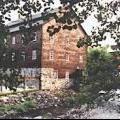 An animal that was essential to the settlers was the sheep, whose fleece could be used to produce wool. On the farms each spring, sheep would be sheared and the wool washed of its natural grease and dirt, combed, and finally carded. Carding was the untangling of the fibres. Hand cards were used. These were wooden palettes about five by seven inches, studded with rows of wire teeth, and fitted with handles. Tufts of wool placed between two of these tools would be raked back and forth until all the fibres lay parallel for spinning. A tedious, time-consuming job that was often left to children, carding resulted in a rope of twisted wool called a "sliver," that could be spun into thread with a spinning wheel or a small hand spinner. The wool could either be left in its natural colour or dyed using dyes from plants or berries. The wool could then be used for knitting or weaving on the loom.
An animal that was essential to the settlers was the sheep, whose fleece could be used to produce wool. On the farms each spring, sheep would be sheared and the wool washed of its natural grease and dirt, combed, and finally carded. Carding was the untangling of the fibres. Hand cards were used. These were wooden palettes about five by seven inches, studded with rows of wire teeth, and fitted with handles. Tufts of wool placed between two of these tools would be raked back and forth until all the fibres lay parallel for spinning. A tedious, time-consuming job that was often left to children, carding resulted in a rope of twisted wool called a "sliver," that could be spun into thread with a spinning wheel or a small hand spinner. The wool could either be left in its natural colour or dyed using dyes from plants or berries. The wool could then be used for knitting or weaving on the loom.
Some parts of the Eastern Townships, Inverness, for example, were originally populated during a wave of Scottish immigration. Many of these new arrivals were sheep farmers who brought their skills with them.
As the raising of sheep increased, the process of handling the wool became too lengthy, so carding mills were built to handle the bulk wool. Settlers could bring their fleece to be processed, carded, and rolled in bundles for use on their spinning wheels and looms. Carding mills were the forerunners of commercial textile and woolen industries.
One early carding mill was established in Magog by Ralph Merry around 1818. From about 1840 to 1860, a number of them were built around the Eastern Townships, producing such items as blankets and yard goods. The largest in Canada was the Paton Manufacturing Company in Sherbrooke. Today, one early survivor is the Ulverton Woolen Mill, built near Ulverton, Quebec in the mid-1800s. Now an interpretation centre, the Mill has a fully operational set of wool-processing machinery and a turbine.